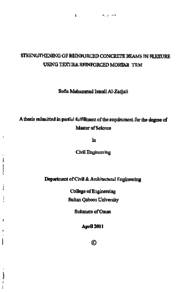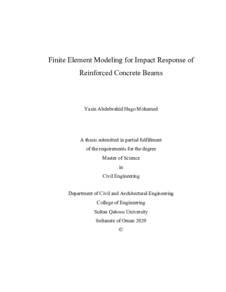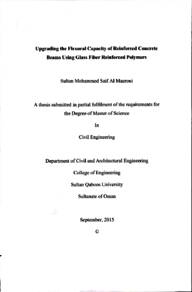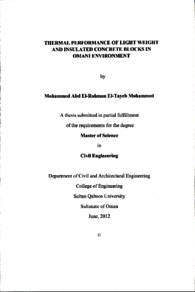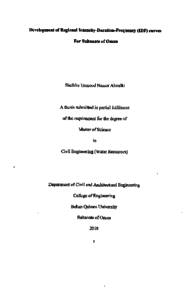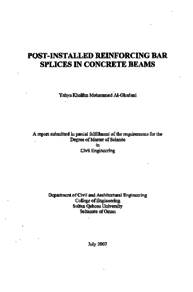Document
Strengthening of reinforced concrete beams in flexure using textile reinforced mortar TRM
Publisher
Sultan Qaboos University
Gregorian
2011
Language
English
Subject
English abstract
A great number of society's resources are invested in existing concrete structures, such as bridges, tunnels, different kind of buildings etc. All of these structures have both an expected function and an expected life span. However, both the function and the life span can be influenced by external factors, e.g. degradation and altered load situations. Further influencing aspects could be mistakes in design or during the construction phase. Repairing and/or strengthening these structures could maintain or increase the function as well as the life span. The strengthening system and also the topic of this research project termed as "Strengthening of Reinforced Concrete Beams in Flexure Using Textile Reinforced Mortar (TRM). The TRM consists in this context of grids of carbon fibers with high tensile strength that are bonded to an existing concrete surface by the use of a cement based bonding agent. The scientific approach in this research is the experimental methods to describe load bearing capacity for the strengthened concrete structure in flexure. The study included casting of eleven reinforced concrete beams (150 x 100 x 2700 mm), in order to be tested for flexural. Ten of these beams were strengthened with textile fibers by using different bonding materials and different number of layers. Beams strengthened with single layer, two layers and three layers of textile fibers with and without U shaped textile fibers confinement. Compared to epoxy as a bonding agent, mortar-saturated textiles may result in generally lower effectiveness in terms of strength about 10-17 % gain in strength but much higher in terms of deformability 50-100%. The test results clearly affirm that as the number of layers
increases, there is no significant increase in strength due to bond failure. When the U-shaped strips were used along with increasing number of textile fiber layers, the gain in flexure strength and gain in ductility was observed. From the results obtained in this study it is believed that TRMs might hold strong promises solution for the structural upgrading of concrete structures ensuring a perfect bond between textile fiber and cement based mortar.
Member of
Resource URL
Arabic abstract
تستثمر الكثير من موارد المجتمع البيئة في تشييد المنشات المختلفة مثل الجسور والمباني وغيرها . ولهذه المنشأت وظائف معينه وعمر افتراضي والتي قد تتغير بفعل عدة عوامل أو نتيجة الأخطاء في التصميم او أثناء فترة البناء . والعمل على إصلاح هذه المنشأت يؤدي الي تحسين وظائفها وعمرها الزمني.
إن موضوع هذه الدراسة يتعلق باصلاح وتقوية الجسور الخرسانية المسلحة باستخدام ألياف الكربون ذات القوة العالية وذلك بإلصاقها في الجانب السفلي (الجانب المشدود) باستخدام مواد اسمنتية ويطلق عليها اختصارا .(TRM)
أن الإطار العلمي لهذه الدراسة يتلخص في استخدام الطرق التجريبية لوصف فاعلية وكفاءة هذه الطريقة لزيادة مقاومة الثني (Flexure ) في الجسور الخرسانية . وتشير نتائج هذه الدراسة أن هذه الطريقة تقدم حلا جيدا لتحسين وزيادة مقاومة هذه الجسور خصوصا اذا تم التحكم في كفاءة لصق الألياف بسطح الخرسانة
إن موضوع هذه الدراسة يتعلق باصلاح وتقوية الجسور الخرسانية المسلحة باستخدام ألياف الكربون ذات القوة العالية وذلك بإلصاقها في الجانب السفلي (الجانب المشدود) باستخدام مواد اسمنتية ويطلق عليها اختصارا .(TRM)
أن الإطار العلمي لهذه الدراسة يتلخص في استخدام الطرق التجريبية لوصف فاعلية وكفاءة هذه الطريقة لزيادة مقاومة الثني (Flexure ) في الجسور الخرسانية . وتشير نتائج هذه الدراسة أن هذه الطريقة تقدم حلا جيدا لتحسين وزيادة مقاومة هذه الجسور خصوصا اذا تم التحكم في كفاءة لصق الألياف بسطح الخرسانة
Category
Theses and Dissertations

